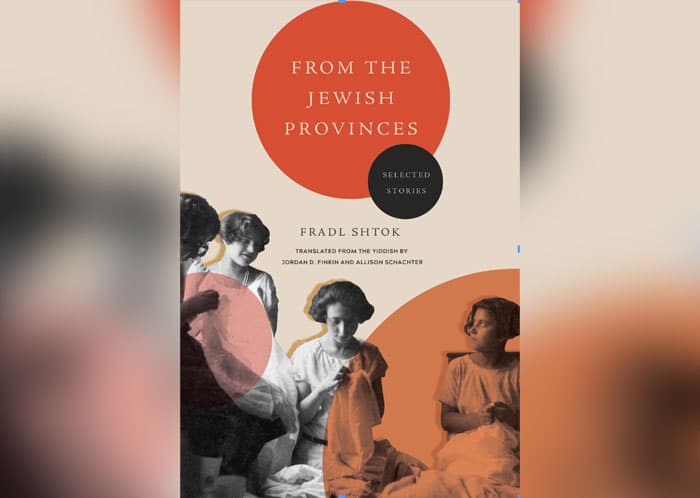
In “The First Train,” the opening story of Fradl Shtok’s collection, “From the Jewish Provinces,” translated from the Yiddish for contemporary English-speaking audiences by Jordan D. Finkin and Allison Schachter, readers feel, through Shtok’s colorful characters, the jolting impact of modernity on a Galician shtetl at the turn of the twentieth century. Like Max Gross’s novel “The Lost Shtetl,” winner of last year’s National Jewish Book Award, “The First Train” maps the changes that ripple through the lives of those who have always been insulated from the progress, and dangers, of the world around them.
But while Gross delineates these changes over the course of more than 500 pages, Shtok demonstrates them in a mere four and a half. Indeed, all of Shtok’s stories, the bulk of them drawn from his “Gezamelte Ertsehlungen” (Collected Stories) published in 1919, are condensed and economical, each a mere hair of an experience. Yet their recurring themes—an attraction to life beyond the shtetl, women’s resistance to the strictures of religious Judaism, communal fears of Zionism and freethinking, and the fantastical possibilities of the imagination—come together like strands of a human-hair sheitel, or marital wig. The result is a collection that both fulfils our expectations of shtetl life and upends them. In “Shorn Hair,” the story of a woman who, having only been married a few months, and to an old man who couldn’t consummate the marriage, rebels against the custom of covering her head by growing, plucking, and then slowly weaving strands of her own hair together until she can go out in “her own hair” that is also, simultaneously, a wig.
For over half a century, feminists have been rescuing women’s writing from the oubliettes of history.
For over half a century, feminists have been rescuing women’s writing from the oubliettes of history. Without novelist Alice Walker, we wouldn’t have Zora Neale Hurston’s powerful and lyrical Harlem Renaissance classic, “Their Eyes Were Watching God,” first published in 1937 (and harshly critiqued by the Black male literati) and revived in the ’70s; without scholar Alice Kessler-Harris, we wouldn’t find Anzia Yezierska’s 1925 Jewish American coming-of-age novel “Bread Givers,” now a staple in American literature courses. The act of literary recovery is not only a feminist project: Famously, “Moby Dick” (1851) was widely panned on publication and only canonized when D. H. Lawrence celebrated it in the 1920s, some 30 years after Herman Melville’s death. But it is particularly pressing when it comes to women writers, as so many talented women were dismissed by their male peers, ignored by the literary establishment and universities, and then forgotten. This is doubly true when these women were ethnic or racial minorities; in my work as a feminist literary scholar, I’ve spent time digging up the stories of incredible women, including the Eaton sisters, Winnifred and Edith, the first Asian North American fiction writers; and Miriam Michelson, a Jewish woman journalist, novelist, and activist who was instrumental in obtaining the vote for women in California.
The process of recovering Yiddish fiction by American women is newer, a product, most likely, of the growing popularity of Yiddish Studies in academia. In the last few years, we’ve been allowed new glimpses into Jewish American literary history thanks to Anita Norich, who translated Kadya Molodovsky’s “A Jewish Refugee in New York,“ and Ellen Cassedy and Yermiyahu Ahron Taub, who translated the essays and stories of Blume Lempel in “Oedipus in Brooklyn and Other Stories.” Both Molodovsky and Lempel escaped Nazi-occupied Europe to settle in the United States. Closer in age—and time of writing—to Shtok was Miriam Karpilove, whose “Diary of a Lonely Girl, Or the Battle Against Free Love,” a work of fiction originally serialized in a Yiddish newspaper 1916-18, was recently translated by Jessica Kirzane; with its insights about men behaving badly and the subtle (and not so subtle) ways women are discriminated against, Karpilove’s “diary” still feels fresh and relevant today.
In “From the Jewish Provinces,” the stories bridge the divide between Old World and New.
In “From the Jewish Provinces,” Shtok’s stories bridge the divide between Old World and New. The majority of the stories center on recurring characters in the Galician shtetl, but there are also sketches of immigrant life in America, and the final story, published in 1942, takes place, rather surprisingly, at a trading post on the Canadian border. The stories are written in the third person, but Shtok relies heavily on free indirect discourse—that form of narration that allows readers to know what the characters are thinking even if we don’t have direct access to them. As characters latch onto an idea or dream, Shtok uses repetition to drive home the emotional impact of the notion. “The Pear Tree,” for example, tells the story of a man named Leyzer and his devotion to his pear tree; through the repeated linking of the pear tree’s successful growth to Leyzer and his wife Pessi’s inability to have children, however, we come to see that the triumph of the pear tree is the tragedy of the couple.
Not all the stories in “From the Jewish Provinces” will resonate with readers today. The unhappy Jewish female characters’ longing for blond, gentile men to whisk them away from their mundane or oppressive lives reads as a valorization of white saviors, even if the white saviors don’t actually do much saving. The Jewish mothers trying to solve all their children’s woes with chocolate custard can feel pretty close to the stereotype of an overbearing Jewish mother. But despite these faults, and in addition to the window Finkin and Schachter, through Shtok, open onto the lives of Yiddish-speaking shtetl dwellers and immigrants to the United States, Shtok’s deft humor, her insights about human nature, and the determination and strength of her characters (particularly the female characters) make this collection a worthwhile read.
Karen E. H. Skinazi, Ph.D, is a senior lecturer and the director of Liberal Arts at the University of Bristol (UK) and the author of Women of Valor: Orthodox Jewish Troll Fighters, Crime Writers, and Rock Stars in Contemporary Literature and Culture.






















 More news and opinions than at a Shabbat dinner, right in your inbox.
More news and opinions than at a Shabbat dinner, right in your inbox.